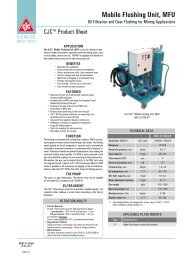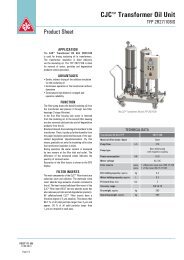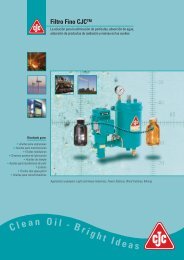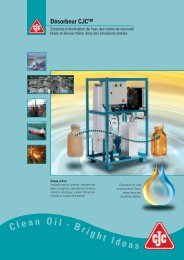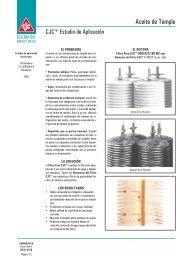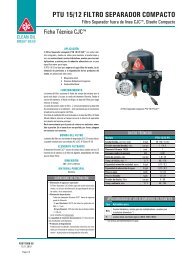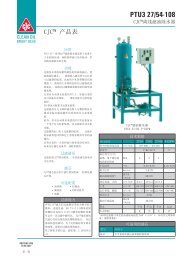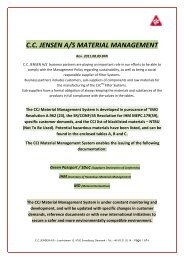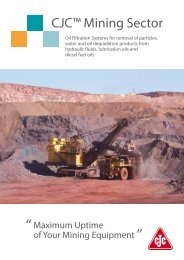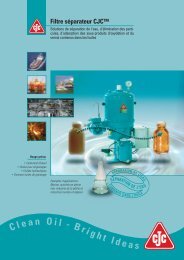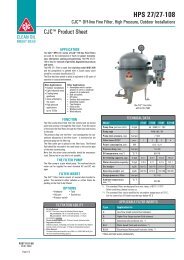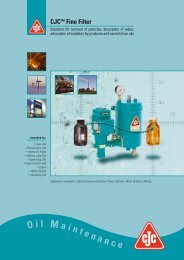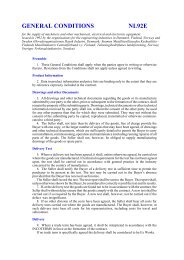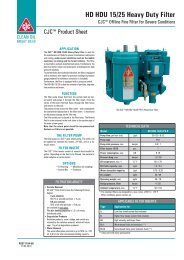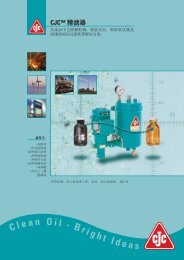Oil Cleanliness in Wind Turbine Gearboxes - Cjc.dk
Oil Cleanliness in Wind Turbine Gearboxes - Cjc.dk
Oil Cleanliness in Wind Turbine Gearboxes - Cjc.dk
You also want an ePaper? Increase the reach of your titles
YUMPU automatically turns print PDFs into web optimized ePapers that Google loves.
<strong>Oil</strong> <strong>Cleanl<strong>in</strong>ess</strong> <strong>in</strong> W<strong>in</strong>d Turb<strong>in</strong>e <strong>Gearboxes</strong>Robert Errichello and Jane Muller, GeartechThe Importance of Clean <strong>Oil</strong>Researchers from London’s Imperial College, Sayles and Macpherson1, showed roll<strong>in</strong>g elementbear<strong>in</strong>g life can be <strong>in</strong>creased up to seven times by chang<strong>in</strong>g from a 40-mm filter to a 3-mm filter.Their results also show that a gearbox must be clean after assembly or a f<strong>in</strong>e filter will not beeffective. This occurs because gears and bear<strong>in</strong>gs can suffer permanent damage <strong>in</strong> as little as 30m<strong>in</strong>utes dur<strong>in</strong>g run-<strong>in</strong>, before a filter can remove built-<strong>in</strong> contam<strong>in</strong>ation.The authors have found wide variation <strong>in</strong> gearbox performance from many <strong>in</strong>spections and failureanalyses. Some gearboxes suffer severe contam<strong>in</strong>ation and fail. Other gearboxes operate withcontam<strong>in</strong>ant-free oil and run successfully for years. The authors believe vary<strong>in</strong>g performance islargely due to differences <strong>in</strong> the design of the gearbox and lubrication system, and differences <strong>in</strong>assembly cleanl<strong>in</strong>ess. Diligence is required throughout the manufactur<strong>in</strong>g, assembly and <strong>in</strong>itialrun-<strong>in</strong> process to assure reliable gearboxes.Many variables determ<strong>in</strong>e a gearbox’s resistance to contam<strong>in</strong>ation and its performance.Types of Contam<strong>in</strong>antsW<strong>in</strong>d turb<strong>in</strong>es <strong>in</strong> desert environments are exposed to airborne dust dur<strong>in</strong>g the hot season andmoisture dur<strong>in</strong>g the ra<strong>in</strong>y season. Offshore turb<strong>in</strong>es are constantly exposed to moisture.Solid particle contam<strong>in</strong>ants vary <strong>in</strong> hardness, friability and ductility, depend<strong>in</strong>g on the compositionof the particle. Common contam<strong>in</strong>ants like rust and black iron oxides have a Mohs hardnessrat<strong>in</strong>g of five to six (on a scale of 1 to 10, with 10 be<strong>in</strong>g the hardest). Environmental dust, mostlysilica, has a hardness rat<strong>in</strong>g of two to eight. Quarry dust has a rat<strong>in</strong>g of five to n<strong>in</strong>e. From themanufactur<strong>in</strong>g process, tool steel has a hardness rat<strong>in</strong>g of six to seven. Silicon carbide andalum<strong>in</strong>um oxide have a hardness rat<strong>in</strong>g of n<strong>in</strong>e. Diamond tops the scale with a hardness rat<strong>in</strong>g often. The size, hardness and friability or ductility of the particle <strong>in</strong>fluence the amount of damagethat the particle can cause.
Sources of Contam<strong>in</strong>ationContam<strong>in</strong>ation can enter gearboxes dur<strong>in</strong>g manufactur<strong>in</strong>g, be <strong>in</strong>ternally generated, <strong>in</strong>gestedthrough breathers and seals, and <strong>in</strong>advertently added dur<strong>in</strong>g ma<strong>in</strong>tenance. All of these sourcesmust be addressed to limit the impact that contam<strong>in</strong>ation can have on components.M<strong>in</strong>imiz<strong>in</strong>g Built-<strong>in</strong> Contam<strong>in</strong>ationFilters do not immediately remove built-<strong>in</strong> manufactur<strong>in</strong>g debris. Consequently, permanent debrisdents and other damage may occur dur<strong>in</strong>g run-<strong>in</strong>, unless gearboxes are assembled <strong>in</strong> a cleanroom us<strong>in</strong>g clean assembly procedures and then filled with clean lubricant. There are manysources of contam<strong>in</strong>ation to elim<strong>in</strong>ate long before the gearbox is placed <strong>in</strong>to service.For <strong>in</strong>stance, the <strong>in</strong>terior of gear hous<strong>in</strong>gs should be pa<strong>in</strong>ted with white epoxy sealer to provide ahard smooth surface that is easy to clean, seals porosity and seals <strong>in</strong> debris like cast<strong>in</strong>g sand. Allcomponents for assembly should be properly stored <strong>in</strong> a dry area prior to assembly. All gears andbear<strong>in</strong>gs should be covered, and bear<strong>in</strong>gs should be stored on their sides.All components should be cleaned prior to assembly. Initial clean<strong>in</strong>g should be done <strong>in</strong> an areaseparate from the clean room, followed by f<strong>in</strong>al clean<strong>in</strong>g <strong>in</strong> the clean room just prior to assembly.All components should be carefully <strong>in</strong>spected to ensure they are clean and rust-free beforeassembly. Pay special attention to bolt holes, oil passages and other cavities that may conta<strong>in</strong>dirt.<strong>Gearboxes</strong> should be assembled <strong>in</strong> a clean room separate from any manufactur<strong>in</strong>g processessuch as mach<strong>in</strong><strong>in</strong>g, gr<strong>in</strong>d<strong>in</strong>g, weld<strong>in</strong>g or deburr<strong>in</strong>g. W<strong>in</strong>dows and doors should be adequatelysealed to prevent contam<strong>in</strong>ation <strong>in</strong>gression and the ventilation system should be filtered so itprovides clean, draft-free air. The floor should be pa<strong>in</strong>ted and sealed so it is easily cleaned andthe overhead structure should be pa<strong>in</strong>ted and dust-free. No tow motors should be allowed <strong>in</strong> theclean room because they <strong>in</strong>variably <strong>in</strong>troduce contam<strong>in</strong>ants.All work should be done by skilled technicians properly tra<strong>in</strong>ed <strong>in</strong> gearbox assembly. All toolsshould be clean, appropriate for gearbox assembly, <strong>in</strong> good condition and properly calibrated.Table 1 gives guidel<strong>in</strong>es for oil cleanl<strong>in</strong>ess designed to ensure adequate cleanl<strong>in</strong>ess of new oilused for factory tests, cleanl<strong>in</strong>ess of gearbox assembly and cleanl<strong>in</strong>ess of oil used <strong>in</strong> service.<strong>Oil</strong> used for factory tests and service oil should be analyzed for cleanl<strong>in</strong>ess before add<strong>in</strong>g togearboxes. If test oil or service oil does not meet cleanl<strong>in</strong>ess requirements, it should be prefilteredus<strong>in</strong>g a filter with efficiency of b3>200.A 3-um filter is suggested dur<strong>in</strong>g factory test<strong>in</strong>g to remove any contam<strong>in</strong>ation left after assemblyor added dur<strong>in</strong>g test<strong>in</strong>g. After the factory test, the gearbox should be dra<strong>in</strong>ed and flushed, and anew filter should be <strong>in</strong>stalled (if there is an onl<strong>in</strong>e system). If oil does not meet cleanl<strong>in</strong>essrequirements after the factory test has been performed, then the gearbox assembly cleanl<strong>in</strong>essshould be improved.
If oil samples do not meet cleanl<strong>in</strong>ess requirements dur<strong>in</strong>g service, there may beone or more failure modes <strong>in</strong> progress, or seals, breathers or ma<strong>in</strong>tenanceprocedures need to be improved.M<strong>in</strong>imiz<strong>in</strong>g Internally Generated Contam<strong>in</strong>ationContam<strong>in</strong>ants may also be generated <strong>in</strong>ternally. These particles are usually wear debris fromgears, bear<strong>in</strong>gs, spl<strong>in</strong>es or other components result<strong>in</strong>g from micropitt<strong>in</strong>g, macropitt<strong>in</strong>g, adhesion,abrasion or frett<strong>in</strong>g corrosion wear modes.Micropitt<strong>in</strong>g is widespread <strong>in</strong> w<strong>in</strong>d turb<strong>in</strong>e gearboxes and is detrimental because it reduces gearaccuracy, may cause gears to be noisy, and may escalate <strong>in</strong>to other failure modes such asmacropitt<strong>in</strong>g, scuff<strong>in</strong>g or bend<strong>in</strong>g fatigue. Micropitt<strong>in</strong>g contam<strong>in</strong>ates the lubricant with largeamounts of iron particles.The use of accurate and smooth surfaces, surface-hardened gears and spl<strong>in</strong>es, and highviscositylubricants can m<strong>in</strong>imize <strong>in</strong>ternally generated wear debris. External and <strong>in</strong>ternal spl<strong>in</strong>eteeth should be nitrided and force-lubricated to prevent frett<strong>in</strong>g corrosion. Annulus gears shouldbe carburized or nitrided rather than through-hardened because through-hardened gears arerelatively soft and prone to generat<strong>in</strong>g wear debris.Material selection and heat treatment choices that determ<strong>in</strong>e material hardness are especiallyimportant design considerations. Filters cannot remove particles once they become embedded <strong>in</strong>softer gearbox components. Hard particles embedded <strong>in</strong> through-hardened annulus gears cancause polish<strong>in</strong>g (f<strong>in</strong>e-scale abrasive wear) on mat<strong>in</strong>g planet gears. This degrades gear accuracyand adds wear debris. Nonmetallic bear<strong>in</strong>g cages should not be used because they aresusceptible to particle embedment that can result <strong>in</strong> severe abrasive wear on rollers.W<strong>in</strong>d turb<strong>in</strong>es should not be parked for extended periods. Otherwise, frett<strong>in</strong>g corrosion may occuron gear teeth, spl<strong>in</strong>es and bear<strong>in</strong>gs.In addition, wet clutches and brakes should have separate lubrication systems to avoidcontam<strong>in</strong>at<strong>in</strong>g the gearbox with their wear debris.M<strong>in</strong>imiz<strong>in</strong>g Ingressed Contam<strong>in</strong>ationBreathers are used to vent <strong>in</strong>ternal pressure when air enters through seals or when air with<strong>in</strong> thegearbox expands and contracts dur<strong>in</strong>g normal heat<strong>in</strong>g and cool<strong>in</strong>g. The breather should have afilter and desiccant to prevent <strong>in</strong>gress of dust and water. It should be located <strong>in</strong> a clean,nonpressurized area away from contam<strong>in</strong>ants such as brake dust and water. In especially harsh
environments, the gearbox should be completely sealed and havean expansion chamber with a flexible diaphragm to accommodatepressure variation.Most w<strong>in</strong>d turb<strong>in</strong>e gearboxes have labyr<strong>in</strong>th seals that provide longlife and adequately seal <strong>in</strong> oil, but may allow contam<strong>in</strong>ant<strong>in</strong>gression. Therefore, V-r<strong>in</strong>gs should be used as external seals.They are effective, but should have metal shields to protect themfrom damage.M<strong>in</strong>imiz<strong>in</strong>g Contam<strong>in</strong>ation Added Dur<strong>in</strong>gMa<strong>in</strong>tenanceMa<strong>in</strong>tenance <strong>in</strong> w<strong>in</strong>d turb<strong>in</strong>es is difficult and risky. Therefore, thegearbox, lubrication system, work platforms and nacelle hous<strong>in</strong>gshould be designed to ensure ma<strong>in</strong>tenance tasks are readilyaccomplished <strong>in</strong> a safe manner. Breathers, filters, dra<strong>in</strong> ports, fillports, sample ports, dip sticks, magnetic plugs and <strong>in</strong>spection portsshould be designed and located for easy ma<strong>in</strong>tenance andm<strong>in</strong>imization of contam<strong>in</strong>ation.All ma<strong>in</strong>tenance that <strong>in</strong>volves open<strong>in</strong>g the gearbox or lubricationsystem should be performed with good housekeep<strong>in</strong>g procedures.<strong>Oil</strong> should be added from a filter cart connected to the gearbox withquick-connect coupl<strong>in</strong>gs to m<strong>in</strong>imize contam<strong>in</strong>ants <strong>in</strong> the new oiland to m<strong>in</strong>imize contam<strong>in</strong>ant <strong>in</strong>gression dur<strong>in</strong>g the transfer.Many experiments have shown water <strong>in</strong> oil promotes micropitt<strong>in</strong>g.The mechanism is unproven, but may be related to hydrogenembrittlement. All lubricants are susceptible to water contam<strong>in</strong>ation,but ester-based lubricants and m<strong>in</strong>eral oils with antiscuff additivesare especially prone to absorb<strong>in</strong>g water, and generally give lowerfatigue life with high water content. To remove water, the lubricantshould be changed or processed, or an offl<strong>in</strong>e filter with waterabsorption capability should be added.Lubrication systems should be properly designed and carefullyma<strong>in</strong>ta<strong>in</strong>ed to ensure gears receive an adequate amount of cool,clean and dry lubricant. Modern filters are compact and provide f<strong>in</strong>efiltration and long life without creat<strong>in</strong>g large pressure drops. Offl<strong>in</strong>efilters provide f<strong>in</strong>e filtration dur<strong>in</strong>g operation and dur<strong>in</strong>g turb<strong>in</strong>eshutdown. Once the oil is clean, it should stay clean provided thegearbox and lubrication system were properly designed and seals,breathers and ma<strong>in</strong>tenance are adequate.AGMA/AWEA 60062 discusses many elements of the lubricationsystem that determ<strong>in</strong>e oil cleanl<strong>in</strong>ess <strong>in</strong>clud<strong>in</strong>g the follow<strong>in</strong>g:• Lubricant type• Lubricant viscosity• Lubricant volume• Onl<strong>in</strong>e filter• Offl<strong>in</strong>e filter• Bypass valves• <strong>Oil</strong> cooler
• Breather• <strong>Oil</strong> sample ports• Sampl<strong>in</strong>g procedures• Control logic• Condition monitor<strong>in</strong>gAGMA/AWEA 6006-AXX is an <strong>in</strong>dustrial standard written by the American Gear ManufacturersAssociation <strong>in</strong> cooperation with the American W<strong>in</strong>d Energy Association. It provides guidel<strong>in</strong>es forspecify<strong>in</strong>g, select<strong>in</strong>g, design<strong>in</strong>g, manufactur<strong>in</strong>g, procur<strong>in</strong>g, operat<strong>in</strong>g and ma<strong>in</strong>ta<strong>in</strong><strong>in</strong>g gearboxesfor use <strong>in</strong> w<strong>in</strong>d turb<strong>in</strong>es.A lubricant-monitor<strong>in</strong>g program can help prevent gear and bear<strong>in</strong>g failures by show<strong>in</strong>g whenma<strong>in</strong>tenance is required. Lubricant monitor<strong>in</strong>g should <strong>in</strong>clude spectrographic and ferrographicanalysis of contam<strong>in</strong>ation, particle counts and analysis of acidity, viscosity and water content.Used filter elements should be exam<strong>in</strong>ed for wear debris and contam<strong>in</strong>ants.Mechanism and Significance of Debris Dent<strong>in</strong>gLubricant-borne solid particles much larger than elastohydrodynamic (EHL) film thickness can beentra<strong>in</strong>ed between gear teeth and between bear<strong>in</strong>g rollers and raceways due to roll<strong>in</strong>g action.Debris is subjected to enormous pressure under contact. Brittle particles fracture <strong>in</strong>to smallerpieces, with some particles embedd<strong>in</strong>g <strong>in</strong> gear teeth and bear<strong>in</strong>g surfaces, and other smallerfragments pass<strong>in</strong>g through the contacts. Ductile particles larger than the film thickness are able topass through the contacts by the comb<strong>in</strong>ed effects of flatten<strong>in</strong>g of particles and dent<strong>in</strong>g ofsurfaces.Debris dents cause loss of EHL film thickness and lead to stress concentrations at shouldersaround dents. Cyclic contacts at these sites generate pressure spikes, plastic deformation andtensile residual stresses that eventually <strong>in</strong>itiate micropits, which may grow <strong>in</strong>to macropits. Hardfriable particles like titanium carbide pulverize <strong>in</strong>to small fragments and promote abrasion,whereas hard ductile particles like tool steel create deep dents with high shoulders that promotefatigue.References1. Sayles, R. and Macpherson, P. (1982). Influence of Wear Debris on Roll<strong>in</strong>g ContactFatigue. Roll<strong>in</strong>g Contact Fatigue of Bear<strong>in</strong>g Steels. ASTM STP 771. p. 255-274.2. AGMA/AWEA 6006-AXX. Standard for Design and Specification of <strong>Gearboxes</strong> for W<strong>in</strong>dTurb<strong>in</strong>e Generator Systems.Ensur<strong>in</strong>g Clean <strong>Oil</strong>• Pa<strong>in</strong>t gear hous<strong>in</strong>g <strong>in</strong>terior with white epoxy sealer.• M<strong>in</strong>imize built-<strong>in</strong> contam<strong>in</strong>ation by assembl<strong>in</strong>g gearboxes <strong>in</strong> a clean room andus<strong>in</strong>g clean assembly procedures.• Ensure oil used for factory tests meets cleanl<strong>in</strong>ess requirements. If not, prefilterthe test oil.• Use a 3-mm filter dur<strong>in</strong>g factory test to remove any contam<strong>in</strong>ation left after
assembly or added dur<strong>in</strong>g test. After factory test, dra<strong>in</strong> the lubricant, flush thegearbox and <strong>in</strong>stall a new filter element.• Monitor assembly cleanl<strong>in</strong>ess by analyz<strong>in</strong>g oil after factory tests and improveassembly cleanl<strong>in</strong>ess if necessary.• M<strong>in</strong>imize <strong>in</strong>ternally generated wear debris by us<strong>in</strong>g surface-hardened gear teethand spl<strong>in</strong>es, smooth tooth surfaces and high-viscosity lubricants.• Avoid nonmetallic bear<strong>in</strong>g cages. t Do not park turb<strong>in</strong>es for extended periods.• Use separate lubrication systems for wet clutches and brakes.• M<strong>in</strong>imize <strong>in</strong>gressed contam<strong>in</strong>ation by us<strong>in</strong>g labyr<strong>in</strong>th seals, V-r<strong>in</strong>gs and a filtered,desiccant breather located <strong>in</strong> a clean, nonpressurized area.• For harsh environments, seal the gearbox and add an expansion chamber.• M<strong>in</strong>imize contam<strong>in</strong>ation added dur<strong>in</strong>g ma<strong>in</strong>tenance by design<strong>in</strong>g for easyma<strong>in</strong>tenance and follow<strong>in</strong>g good housekeep<strong>in</strong>g procedures. Dur<strong>in</strong>g oil fill, addprefiltered oil from a filter cart connected to the gearbox with quick-connectcoupl<strong>in</strong>gs.• For circulat<strong>in</strong>g-oil systems, use f<strong>in</strong>e filtration. Change or process lubricant toremove water, or use an offl<strong>in</strong>e filter with water absorption capability.• For oil-bath systems, change lubricant at least annually or add an offl<strong>in</strong>e filter.• Monitor service lubricant with spectrographic and ferrographic analysis, particlecounts and analysis of acidity, viscosity and water content. Exam<strong>in</strong>e used filterelements for debris and contam<strong>in</strong>ants.Prevent<strong>in</strong>g Micropitt<strong>in</strong>gThe follow<strong>in</strong>g guidel<strong>in</strong>es summarize methods forprevent<strong>in</strong>g micropitt<strong>in</strong>g. Not every measure may beachievable, but as many as possible should beimplemented.Maximize Specific Film ThicknessIncrease <strong>Oil</strong> Film Thickness• Use highest practical oil viscosity• Keep oil cool• Use synthetic oil if gearbox sump temperature > 80°C (176°F)Reduce Surface Roughness• Avoid shot-peened tooth flanks, or polish flanks after shot peen<strong>in</strong>g• Make hardest gear teeth as smooth as possible• Run-<strong>in</strong> with special lubricant• Prefilter lubricant and use a f<strong>in</strong>e filter (3 mm) dur<strong>in</strong>g run-<strong>in</strong>• Keep oil cool dur<strong>in</strong>g run-<strong>in</strong>
• Run-<strong>in</strong> gears us<strong>in</strong>g a series of <strong>in</strong>creas<strong>in</strong>g loads and appropriate speed• Dra<strong>in</strong> lubricant after run-<strong>in</strong>, flush the gearbox and change the filterOptimize Gear Geometry• Use at least 20 teeth <strong>in</strong> the p<strong>in</strong>ion• Use nonhunt<strong>in</strong>g gear ratio• Use helical gears with axial contact ratio ³ 2.0 t Use aspect ratio £ 1.0 for spur ands<strong>in</strong>gle-helical gears• Use aspect ratio £ 2.0 for double-helical gears• M<strong>in</strong>imize contact stress by specify<strong>in</strong>g high accuracy and optimiz<strong>in</strong>g centerdistance, face width, pressure angle and helix angle• M<strong>in</strong>imize specific slid<strong>in</strong>g by us<strong>in</strong>g profile shift• Use proper profile and lead modificationOptimize Metallurgy• Maximize p<strong>in</strong>ion hardness• Make p<strong>in</strong>ions 2 HRC po<strong>in</strong>ts harder than gears• Use = 20 percent reta<strong>in</strong>ed austeniteOptimize Lubricant Properties• Use oil with high micropitt<strong>in</strong>g resistance as determ<strong>in</strong>ed by test<strong>in</strong>g• Use oil with low traction coefficient• Use oil with high pressure-viscosity coefficient• Avoid oils with aggressive antiscuff additives• Avoid oils with viscosity <strong>in</strong>dex improvers• Keep oil cool• Keep oil free of solid contam<strong>in</strong>ants• Keep oil dry



